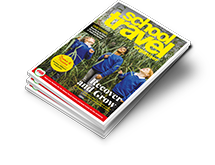Young learners from St Mary’s Church of England School had a blast when they visited The Roman Baths to discover its many historical highlights.

Children from St Mary’s Church of England School in Writhlington near Bath became archaeologists for the day when they visited The Roman Baths. The trip was linked to their current learning topics of History: ‘Rotten Romans’, and English writing.
The learners from Class 3 began their day at the Roman Baths Clore Learning Centre, a separate space dedicated exclusively to learning and community groups. The building was once a Victorian laundry and has been converted into two classrooms, toilets, storage and lunchroom facilities as well as a subterranean space which links to The Roman Baths site.
School: St Mary’s Church of England School
Subjects: History / English
KS: 2
Number of pupils: 23
With the help of The Roman Baths’ workshop leaders, the children from St Mary’s learned about the site and ancient bathing practices. They got to handle replicas of real objects which the Romans used to keep clean: tweezers, a strigil (curved tool for scraping off oil), fingernail cleaners and ear wax removers.
The class were also able to hold and examine copies of artefacts found at the site, such as flue tiles, brick tiles with dog paw prints embedded and real mosaic tesserae. They also designed their own mosaic pattern using small tiles and learned how to dress up in Roman clothing.
Learning spaces at the Roman Baths
A big highlight of the Clore Learning Centre is the Investigation Zone which is an atmospheric underground environment set amidst real Roman remains. Here, children can explore, investigate and record archaeological materials, becoming mini-archaeologists and mini-curators as they participate in learning sessions amongst real Roman archaeology. The floors above contain two new learning spaces known as the Sulis and the Minerva rooms.
The visit to the Learning Centre concluded with the chance for the group to become archaeologists and dig for Roman treasures. The Investigation Zone is beneath street level and features a mock archaeological pit for young learners to dig for replica artefacts from Roman life.
Other hands-on activities included completing a puzzle to create the pediment from the Roman temple and building a Roman arch with wooden blocks. The underground space also houses remains of Roman columns and other stone structures. By using the Alex the Archaeologist app on special iPads, the visiting children were able to play a game to identify the ancient stonework.
“I really liked when we used the iPads to scan real life artefacts.”
Eleanor, KS2 pupil.
The visit finished with the ‘wow’ factor as the school was led through the underground tunnels to come out beside the Great Bath at the centre of the Roman Baths complex. They then explored the different Roman bathing pools and the remains of a Roman gym. Class 3 also got to meet Roman characters who talked about their lives in Aquae Sulis (as Bath was known then).

They also spent time in the museum to see artefacts such as the gilt-bronze head of the goddess Minerva and the remains of the stone pediment that was once positioned at the entrance to the goddess’s temple.
Class teacher, Caitlin Norris, loved the visit which really helped her pupil’s visualise the context that they had been studying in school.
She said: “The educational visit was an engaging and interesting learning experience for the children with plenty of practical activities for them to apply their historical knowledge to.
“We used this experience to support our writing in English: non-chronological report on Roman inventions. Consolidated learning completed throughout the term inspired the children further in their history learning.”
For more information about school visits to the Roman Baths, visit www.romanbaths.co.uk/schools.
To enquire about a visit call 01225 477785 or email romanbaths_bookings@bathnes.gov.uk.










